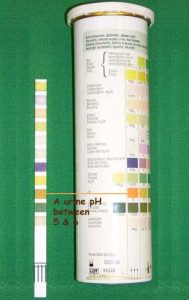Ron Hines DVM PhD
The pH Of Your Dog And Cat’s Urine
The acidity of your pet’s urine (its pH) is influenced by two factors:
1) Your dog or cat’s kidneys produce urine of different acidity as a way to manage control the pH of its body as a whole. In response to diet and metabolic activity its kidneys govern how much or how little acidity leaves through the urine it produces.
2) Urine pH also changes due to changes in its composition while it is stored in the bladder. Much more so after it leaves the body.
So, the pH of your dog or cat urine varies based on many factors; but your veterinarian like to see it slightly acidic – between 6 and 6.9. All carnivores normally produce slightly acidic urine.
In-office tests are usually done using chemically impregnated paper strips. They are OK for rough approximation of your pet’s urine pH, but not much more than that.
Because urine, produced over extended time, is the chief way your pet controls the acidity of its body, a single sample is not a very good indication of the acid:base balance of its body (i.e. not a good way to detect acidosis or alkalosis). For that, things like the anion gap of your pet’s blood and blood bicarbonate level need to be examined.
Reasons Why Your Dog Or Cat’s Urine pH Could Be Higher Than Normal (= more basic, more alkaline):
The most frequent cause by far is a urinary tract infection.
Your pet’s urine can also become slightly more basic after it eats (the postprandial alkaline tide).
I suppose that feeding a dog or cat a very inappropriate, no-meat or low-meat, high carb, high sugar diet could account for a high urine pH (that is the case, at least, in humans and the normal situation in all vegetarian livestock).
Any dish washing soap or bleach left in the urine collection container you used to bring in the specimen can raise urine pH. Urine pH also rises in stale urine – the sample needs to be fresh, kept on ice or refrigerated. (Better yet is a sample collected at the veterinary hospital just before the test is performed.)
That rise in pH as urine sits in a cup can be due to bacterial contaminants that split waste urea into more basic ammonia, as well as to escape of of initial acidic C02 from the sample over time.
Reasons Why Your Pet’s Urine pH Could be Be Lower than Normal (more acidic):
The normal diet of dogs and cats contains considerable animal protein. And diets high in meat protein naturally produce slightly acidic urine.
However, any of the conditions listed for metabolic acidosis also have the potential to lower your pet’s urine pH beyond what is desirable. Those include chronic kidney disease and uncontrolled diabetes. Chronic diarrhea is said to also have the potential to cause more acidic urine (lower pH urine) as basic body ions are lost in the large volumes of watery stool.
Urinary tract acidifiers (e.g. dl-methionine, ammonium chloride) were once administered to acidify urine in an attempt to dissolve struvite bladder stones. They were relatively ineffective in keeping urine acidic but could account for temporarily lower urine pH readings. They have been mostly replaced, by specialty therapeutic diets that do a better job and rely more on producing a very dilute urine rather than a very acidic one.
Complementary Tests:
Complete urinalysis, urine bacterial culture, confirm urine pH reading with multiple fresh urine specimens, confirm urine pH with a pH meter, review of your pet’s diet, Further tests as suggested by your veterinarian based on those initial test results and his/her physical examination of your pet and its history.
DxMe
